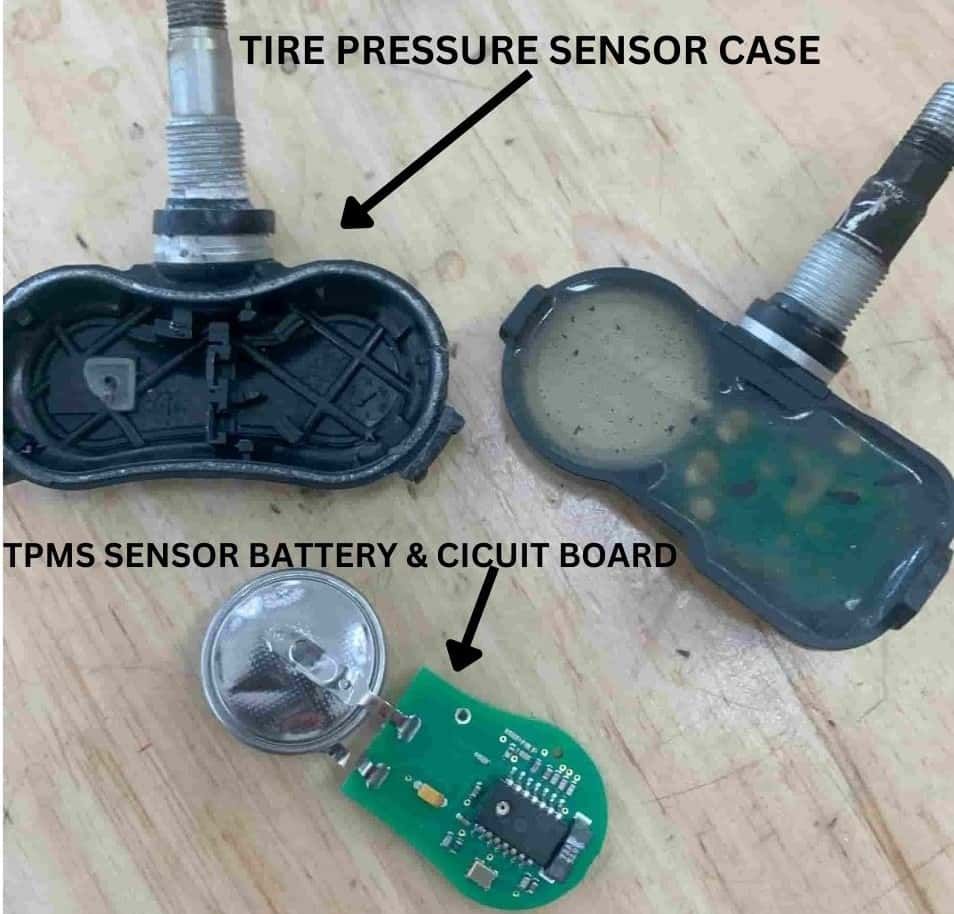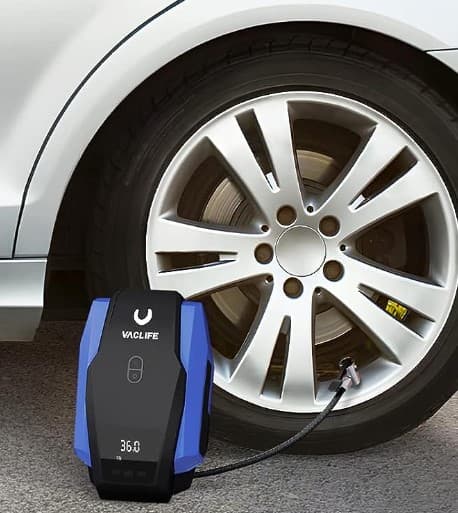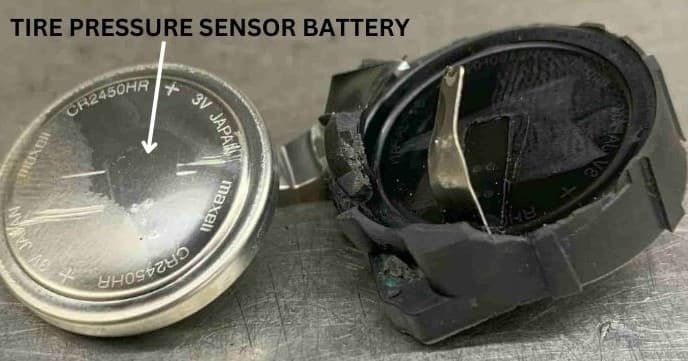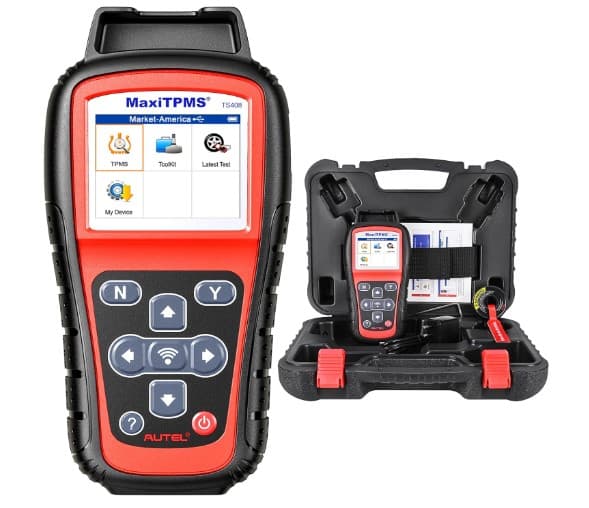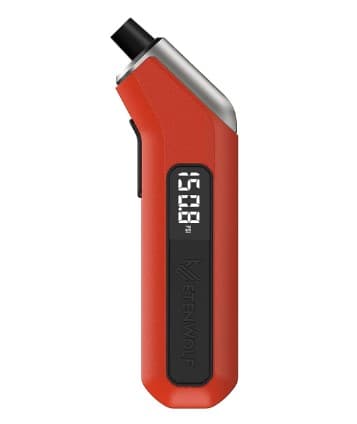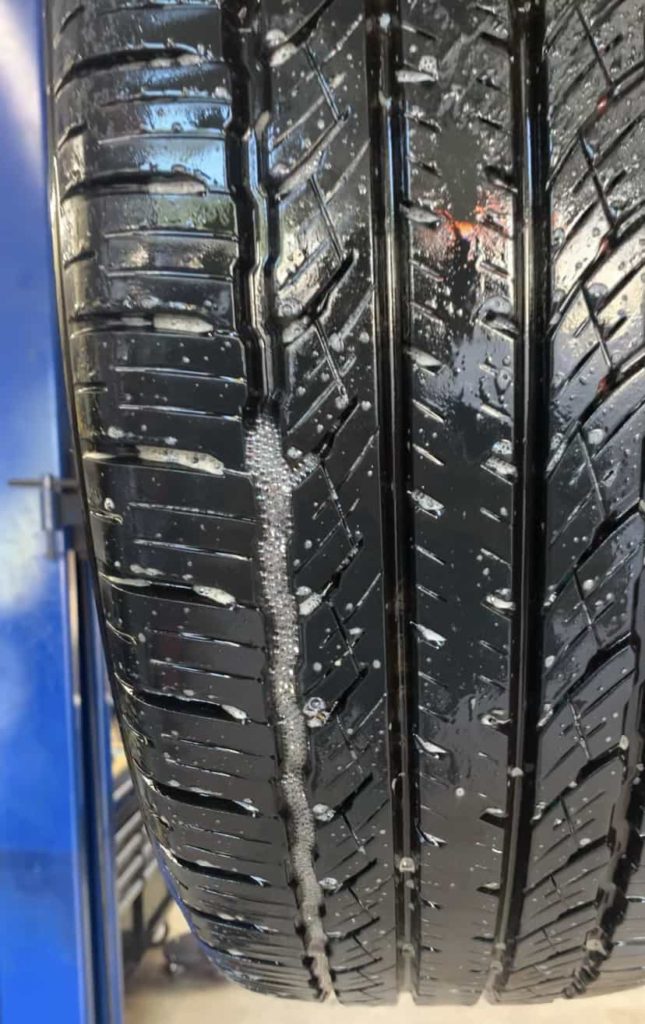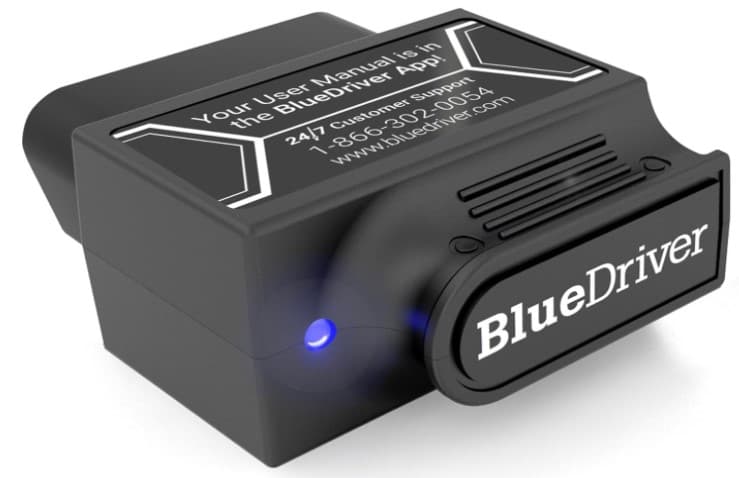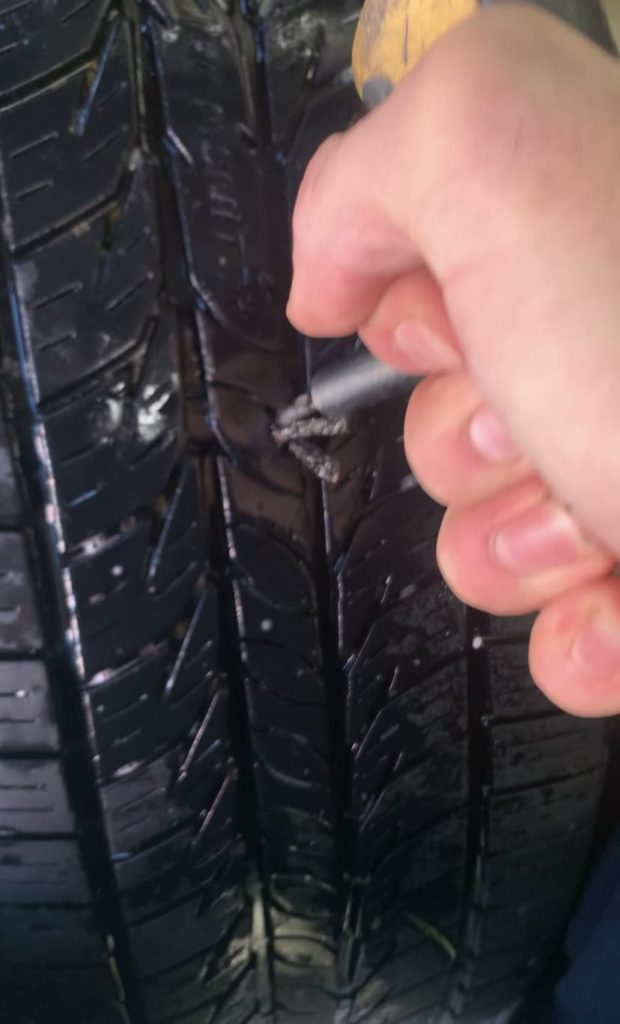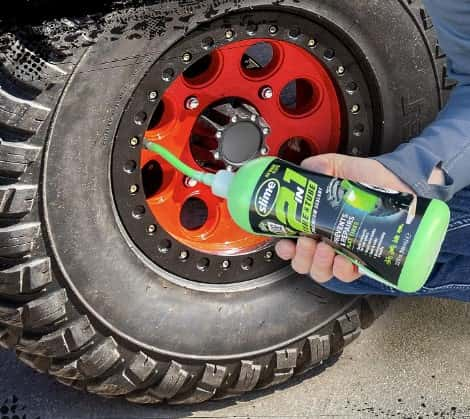Chrysler 300 Tire Pressure Monitoring System
The TPMS (tire pressure monitoring system) in the Chrysler 300 consists of sensors for tire pressure, a TPMS receiver module, the primary computer (ECM) of the Chrysler 300, and alerts indicating low tire pressure. These elements function in unison to provide real-time tire pressure data and alert the driver when the pressure descends beneath a set point.
How Does the Chrysler 300 TPMS Work?
Pressure Measuring Sensors: Tucked inside every tire, these sensors keep a continuous tab on the tire’s air pressure and temperature. Even though they’re out of sight, located at the valve stem’s base, they consist of a battery-powered circuit board with an antenna, all wrapped in a protective plastic shell.
Transmission of Data: Working wirelessly, these sensors send over the temperature and pressure specifics of the tire to the Chrysler 300 computer. They utilize radio frequencies to transmit tire data, predominantly on the 315 Mhz or 433 Mhz bands.
TPMS Receiver Unit: Serving as a go-between, this unit receives data from the sensors, refines it, and then dispatches it to the Chrysler 300’s central computer.
Brain of the System – ECM: The Engine Control Module, or ECM, makes the crucial decisions. Analyzing the received data, it ascertains if the tire pressure and temperature is in the acceptable range.
Warning System: If a pressure anomaly is detected, the ECM gets proactive. The driver is immediately informed with a dashboard light (yellow exclamation point) and an auditory chime. A precise message, “Tire Low Inflate to XX PSI”, specifies the affected tire and its required pressure.
System Diagnostic Alert: The TPMS is self-aware. Any communication lapse between a sensor and the ECM is promptly flagged with a flashing tire indicator alert and a “SERVICE TPM SYSTEM” directive.
Steps to Reset Chrysler 300 TPMS
Park the Chrysler 300 on level/flat terrain.
Adjust the air pressure in all four tires to the correct levels when they are at a cold state.
Drive your Chrysler 300 for at least a duration of 20 minutes with a speed greater than 15 Mph (24 km/h).
Steps to Deactivate Chrysler 300 TPMS
Should you wish to deactivate the Tire Pressure Monitoring System (TPMS) of your Chrysler 300, it necessitates replacing all four wheels with wheels devoid of tire pressure sensors. Be aware: if you follow this procedure, instead of tire pressure values on the information screen, you will see dashes (~).
Swap all four wheels and tires with wheels that exclude TPMS sensors.
Drive your Chrysler 300 for no less than 20 minutes, maintaining a speed above 15 mph.
You will hear a chime sound from the TPMS.
The TPMS warning icon (a yellow exclamation mark) will intermittently flash for around 75 seconds, then stay on.
The “SERVICE TPM SYSTEM” notification will materialize on the display screen and dashes (~) will substitute the tire pressure readings.
Cycle the engine On and Off.
Upon engine cycle completion, the “SERVICE TPM SYSTEM” notice will vacate the display, but tire pressure readings will be replaced by dashes(~).
Steps to Reactivate the Chrysler 300 TPMS
Reattach the Chrysler 300’s OEM wheels and tires, ensuring the OEM tire pressure sensors are installed and functioning.
Drive in your Chrysler 300 for a duration of about 20 minutes, maintaining a speed over 15 mph (24 km/h).
Await an audible chime from the tire pressure system (inside the cabin of the car).
Observe the TPMS alert light (indicated by a yellow exclamation mark) which will blink for approximately 75 seconds before turning off.
The display screen will project a “SERVICE TPM SYSTEM” message.
Numeric tire pressure values will reappear, replacing the (~) dashes on the display.
Toggle the ignition switch between its on and off states.
Drive the Chrysler 300.
2023 Chrysler 300 Tire Pressure
TIRE SIZE | FRONT PSI | REAR PSI |
215/65R17 | 32 | 32 |
225/60R18 | 32 | 32 |
235/55R19 | 30 | 30 |
245/45R20 | 32 | 32 |
Reasons the Chrysler 300's Low Tire Pressure Indicator Activates
Tires with low air pressure
Tires filled beyond recommended levels
Tires experiencing air leakage
Missing or broken pressure sensors in tires
Aged or malfunctioning TPMS battery
Technical issues in TPMS receiver module or the Chrysler ECM
External electronic disruptions
Variations in climatic conditions or height above sea level (altitude)
Exceeding the vehicle’s weight capacity
Employing chains on the wheels
Heavy window tint film application
Road temperature alterations
Tires showing signs of wear or damage (dry-rot, puncture, bubble, etc..)
Inconsistent tire or wheel sizes being used
Incorrect wheel alignment
Issues in TPMS software functioning
Driving over obstacles (potholes/curbs) or rough terrains
Faulty tire installation. (TPMS sensors can be easily broke when mounting new tires)
Overlooking TPMS reset after changing or rotating tires.
Chrysler 300 Tire Pressure Sensor Batteries
A tire pressure sensor is mounted inside each tire to each Chrysler 300 wheel. Each TPMS sensor consists of a circuit board, an antenna, and a small silver-oxide 3 volt battery that cannot be replaced or recharged as it’s firmly connected to its circuit board. The entirety of the sensor requires replacement once its battery is low on power or drained. Generally, the tire pressure sensors of a Chrysler 300 are expected to stay powered from 5-10 years or roughly 100,000-150,000 driving miles.
Troubleshooting the Chrysler 300's Tire Pressure Light Problems
The usual way to reset the Chrysler 300’s tire pressure light might not consistently switch off the tire light. When this light is active, there’s an underlying reason. Determining this issue often means experimenting with multiple solutions until the right one is found.
Solution 1: Checking for a Tire That's Leaking Air
When the tire light on your Chrysler 300 activates during a drive, immediately stop driving and assess the air pressure in all tires. After pinpointing the tire with low air, adhere to the following:
Pump the tire in question up to the advised 32 Psi and visually inspect the tire. Do the same for the other tires.
Drive your Chrysler 300 for a short duration, ensuring to drive over 15 mph.
Afterward, the tire light should extinguish.
⏩ CLARIFICATION: More often than not, when there’s a disparity in air pressure, with one tire being noticeably lower, it can imply a tire puncture or leak. If the low tire pressure signal deactivates once the tire is inflated and the Chrysler has been driven, this confirms that low pressure was the culprit. If, however, the warning light reactivates post its initial deactivation, re-examine the pressures. A recurring decrease in the same tire’s pressure hints at a leak. For leak detection methods, see Solution 6.
Solution 2: Clearing the Tire Light DTC and Resetting the Chrysler 300's ECM
Every low tire pressure notification is stored within the Chrysler 300’s ECM. To attempt to wipe this stored data, you can essentially compel the ECM to restart. Here’s the method:
Turn off the Chrysler 300’s engine and all its electronic components, such as the radio, lights, and so on.
Lift the car’s hood, loosen and unhook the negative terminal from the 12-volt battery.
Allow the vehicle to remain idle for a few moments, then re-secure the terminal to the battery’s negative post.
We suggest driving your Chrysler 300 on highways for about 30 minutes after the battery intervention so all the sensors can recalibrate.
⏩ INSIGHTS: Upon re-establishing power to the Chrysler 300’s ECM, the tire indicator should go off. Should the low tire pressure signal reactivate while driving or thereafter, it either hints at a tire losing air or a tire pressure sensor having a diminished or exhausted battery. Follow solution 3 to learn how to test each tire sensor.
Solution 3: How to Check Tire Pressure Sensors With a TPMS Programming Tool
When your tires are evidently not under-inflated or losing air, but the tire pressure warning persists, it points towards a potential flaw or glitch in a tire pressure sensor of one or several tires. To scrutinize each sensor, you’d require a TPMS programming tool or an OBD2 scanning tool. Note that the OBD2 scanning device will only spotlight the wheel/tire generating the diagnostic trouble code, whereas the TPMS tool will elaborate both on the wheel and its associated problem. Here’s the method to test each sensor using the TPMS programming tool:
Plug the TPMS programming unit to the Chrysler’s OBD2 interface and follow the prompts displayed on-screen.
Begin with the tire situated at the front left (driver’s side) and align the tool directly in front of the tire pressure valve/sensor.
On the tool interface, select the “test” or “trigger” feature.
After the sensor is tested, the tool will instruct you to test the front right tire and so on.
⏩BRIEF: After successfully testing all 4 of the TPMS sensors, the TPMS programming tool will proffer a comprehensive analysis report. If the TPMS tool cannot successfully test a sensor, reports absurd metrics (e.g., a tire’s temperature registering at -135 degrees), or flag a battery as low or dead, that TPMS sensor needs to be replaced.
Solution 4: Reviving a Non-Responsive Tire Pressure Monitor Sensor
There are instances where the tire indicator becomes active because a tire pressure sensor isn’t responsive. If the battery of the sensor isn’t the problem, follow this process:
Reduce the air of the tire by 15-20 Psi.
Refill the tire to its specified pressure, but add an extra 5 Psi. (So, if it should be at 32 Psi, adjust it to 37 Psi)
Drive the Chrysler 300 and ensure your speed exceeds 15 Mph.
Afterwards, deflate the tire pressure back to its originally recommended value.
⏩CONCLUSION: It’s worth giving this method a shot if the conventional tire pressure resetting technique falls short.
Solution 5: Erratic Behavior of the Low Tire Pressure Warning Light
If the low tire pressure indicator on your Chrysler 300 toggles on and off sporadically, it’s often attributable to weather changes. A temperature swing is a frequent trigger for the tire alert. As a general principle, for every 12-degree alteration in the atmospheric temperature, there’s a congruent change of at least 1 Psi in tire pressure. So, a transition from 75 to 35 degrees could lead to a pressure drop of roughly 4-5 Psi, activating the warning light. However, as you proceed with your journey and temperatures ascend, the ensuing tire warmth raises the internal pressure, causing the alert to turn off.
⏩INSIGHT: We might not hold sway over atmospheric conditions, but what’s feasible is determining and fine-tuning tire pressures when they’re in a cold state. You can ascertain that the tires are cold if the Chrysler 300 has remained undriven for over 3 hours. Adopting this strategy ensures optimal pressure adjustments, tempering the influence of climatic shifts on tire pressures.
Solution 6: Finding the Cause of the Tire Air Loss
For a precise determination of where a tire is leaking, you’ll require a set of tools: a tire air pump, a spraying container, water, and liquid soap. Procedure to find the air pressure leak:
Mix the water and liquid soap (ordinary dish soap suffices) in the spraying container.
Ensure the deflating tire is pumped to no less than 32 Psi.
Spray the entire tire comprehensively with the concocted solution.
Closely scrutinize the tire, on the lookout for small air bubbles.
⏩FOLLOW-UP: Upon locating the bubbles, trace their path to find the source, which indicates the site of the leak.
Chrysler 300 TPMS Questions
Steps to Manage TPMS Sensors When Changing Wheels or Tires
When altering or substituting the tires of your Chrysler 300, it’s vital to undertake the TPMS reset protocol. Conversely, if the wheels or rims are being replaced, the original tire pressure sensors should either be migrated to the new wheels or new TPMS sensors should be fitted. The next step involves configuring the new sensors to Chrysler 300’s ECM by using a TPMS programming tool.
How Altitude Changes Impact Tire Pressure in a Chrysler 300
Navigating through diverse altitudes with a Chrysler 300 necessitates mindful attention to variations in tire pressure, which are intrinsically linked to atmospheric pressure changes. Scientifically speaking, a gain of 1,000 feet in altitude can correlate with a reduction of roughly 0.5 psi in tire pressure due to the diminished atmospheric pressure at loftier heights. Imagine driving from an area at sea level to a high-altitude region of 6,500 feet – this could equate to a 3.5 psi reduction in tire pressure.
Driving the Chrysler 300 With the Low Tire Pressure Light On
Should the tire light on your Chrysler 300 activate, pull over safely and determine the reason. Assess whether the tire pressure is depleted or if it’s adequate despite the ongoing tire light indication. A persisting tire light with accurate tire pressure points towards a miscommunication between the TPMS sensors and the Challenger’s ECM. Prioritize the safety of your vehicle and passengers by avoiding driving with low tire pressure and consult the previously mentioned solutions to identify and address the problem.
How Far Can You Drive the Chrysler 300 With the Low Tire Pressure Light On?
Driving the Chrysler 300 with an active low tire pressure light introduces risks to the vehicle and its passengers. There isn’t a definitive number of miles or time limit for driving under these conditions, as it hinges on specific variables. If the pressure in the tires is low, it’s imperative to inflate them before continuing your journey. On the other hand, if the tire pressure is adequate yet the light persists, this is indicative of a TPMS issue. Driving with a TPMS issue isn’t directly hazardous but does mean you’ll be unaware of the precise tire pressure, which carries its own risk factors.
Why is the Chrysler 300 Tire Light Flashing?
When the tire light flashes or blinks, it signals a miscommunication between the tire pressure sensor and the TPMS receiver module or ECM of the Chrysler 300. This situation is referred to as a TPMS malfunction and is distinct from air pressure problems. To illustrate, since the spare tire is devoid of a tire pressure sensor, using it means that there is no sensor for the ECM and TPMS receiver module to interface with, resulting in a TPMS malfunction. This can also transpire when a tire pressure sensor is nearing or has exhausted its battery life.
Are Tire Plugs a Recommended Solution for Tire Punctures?
In my experience as an automotive technician, tire plugs have consistently demonstrated their reliability when addressing punctures on tire treads. Although, we advise against using them when the tire tread exhibits considerable wear or in cases where the puncture is situated on the sidewall of the tire.
Do Tire Sealants Affect Tire Pressure Sensors?
Tire sealants, including brands like Fix-a-Flat or Slime, offer valuable quick fixes during emergencies, but bear in mind that they have the potential to harm tire pressure sensors and lead to tire imbalances.
Everything in this article is applicable to all Chrysler 300 models and versions including the Chrysler 300 Touring, Touring L, 300S V6, 300S V8,
Please note that this blog post contains Amazon affiliate links. This means that if you make a purchase through one of these links, we at TPMSRESET.COM may earn a small commission at no extra cost to you. We only recommend products that we personally use and believe in. Thank you for supporting us.

